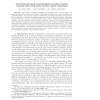Free Online Productivity Tools
i2Speak
i2Symbol
i2OCR
iTex2Img
iWeb2Print
iWeb2Shot
i2Type
iPdf2Split
iPdf2Merge
i2Bopomofo
i2Arabic
i2Style
i2Image
i2PDF
iLatex2Rtf
Sci2ools
118
click to vote
SIAMCO
2010
2010
Anytime Reliable Transmission of Real-Valued Information through Digital Noisy Channels
Abstract. The problem of reliably transmitting a real-valued random vector through a digital noisy channel is relevant for the design of distributed estimation and control techniques over networked systems. One important example consists in the remote state estimation under communication constraints. In this case, an anytime transmission scheme consists of an encoder –which maps the real vector into a sequence of channel inputs– and a decoder –which sequentially updates its estimate of the vector as more and more channel outputs are observed. The encoder performs both source and channel coding of the data. Assuming that no channel feedback is available at the transmitter, this paper studies the rates of convergence to zero of the mean squared error. Two coding strategies are analyzed: the first one has exponential convergence rate but it is expensive in terms of its encoder/decoder computational complexity, while the second one has a convenient computational complexity, but sub-...
| Added | 30 Jan 2011 |
| Updated | 30 Jan 2011 |
| Type | Journal |
| Year | 2010 |
| Where | SIAMCO |
| Authors | Giacomo Como, Fabio Fagnani, Sandro Zampieri |
Comments (0)

